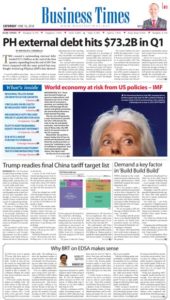BIZ-FINANCE: Manila – PH external debt hits $73.2B in Q1
THE country’s outstanding external debt totaled $73.2 billion at the end of the first quarter, expanding from the end of 2017 but lower compared with the same period last year, Bangko Sentral ng Pilipinas (BSP) data showed.
It was $98 million more than the $73.1 billion recorded as of end-December 2017, largely due to $621 million in foreign exchange revaluation adjustments and another $685-million adjustment due to late reporting.
The 0.8 percent year-on-year drop, meanwhile, was attributed to net principal repayments totaling $3.4 billion.

Key external debt indicators remained at comfortable levels during the first quarter of 2018, the Bangko Sentral said, adding that the country’s gross international reserves of $80.5 billion were enough to pay for 6.3 times short-term debt under the original maturity concept.
Expressed as a percentage of annual aggregate output, the external debt ratio narrowed to 19.1 percent, improving from 20 percent a year earlier,
“The same improving trend was observed using GDP (gross domestic product) as denominator, with the Philippine economy growing by 6.8 percent in the first quarter of 2018” the Bangko Sentral said.
The country’s debt service ratio (DSR) also improved to 7.6 percent from 9.1 percent a year ago. It, however, rose from 6.2 percent as of end-December 2017 but was well below the international benchmark range of 20 percent to 25 percent.
The debt service ratio is a measure of the country’s adequacy to meet its obligations, based on foreign exchange earnings, by relating principal and interest payments to merchandise exports and receipts from services and primary income.
About 82.4 percent of the Philippines’ external debt is medium to long-term in nature with maturities of over one year. This means that foreign exchange requirements for debt payments are well spread out and more manageable, the central bank said.
Of the country’s first quarter external debt, 53.6 percent or $39.2 billion was owed by the public sector. The remainder was contracted by banks and companies.
Loans from multilateral/bilateral creditors and foreign holders of bonds and notes comprised the largest shares of total outstanding debt at 33.6 percent and 30.2 percent, respectively.
Foreign banks and other financial institutions accounted for 28.7 percent while the rest was mostly owed to foreign suppliers/exporters.
By currency, 61.5 percent of the country’s foreign debt was US dollar-denominated, 13.5 percent was in yen, 14.5 percent in multi-currency loans from the World Bank and the Asian Development Bank, and 10.5 percent comprised obligations in 17 other currencies. / BY MAYVELIN U. CARABALLO, TMT ON









